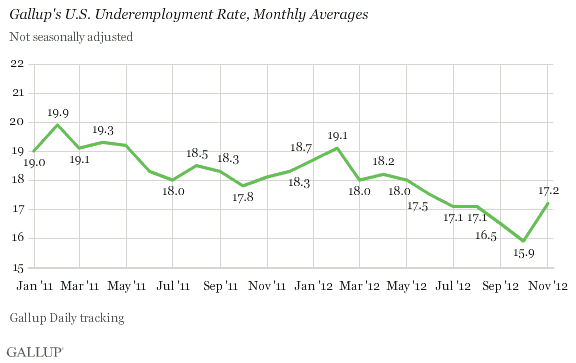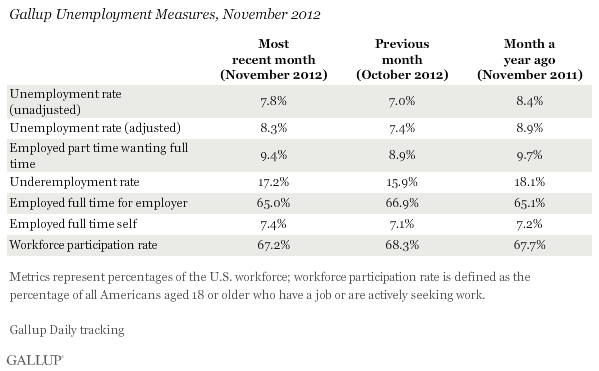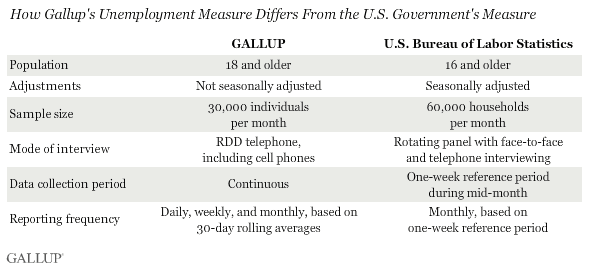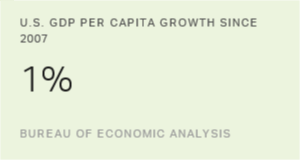WASHINGTON, D.C. -- U.S. unemployment, as measured by Gallup without seasonal adjustment, was 7.8% for the month of November, up significantly from 7.0% for October. Gallup's seasonally adjusted unemployment rate is 8.3%, nearly a one-point increase over October's rate.

These results are based on Gallup Daily tracking interviews, conducted by landline and cell phone, with approximately 30,000 Americans throughout the month -- 67.2% of whom are active in the workforce. Gallup calculates a seasonally adjusted unemployment rate by applying the adjustment factor the government used for the same month in the previous year. Last year, the government adjusted the November rate upward by 0.5 percentage points.
It is unclear what caused the increase in the unemployment rate in November, although some experts speculate that it was caused by jobs lost as a result of superstorm Sandy. It is also possible that lackluster holiday hiring is to blame.
Although the increase in the unadjusted rate in November is a sharp contrast to the 0.9-point decline seen in October, November's 7.8% rate is still tied for the second-best unadjusted unemployment monthly reading of 2012. However, on an adjusted basis, November's rate is the highest reading in six months. Looking at year-to-year comparisons, seasonally adjusted unemployment is down from 8.9% in November 2011.
Underemployment, as measured without seasonal adjustment, was 17.2% in November, a 1.3-point increase since the end of October. The uptick in November also puts an end to the six-month trend of improvements or no change. Still, underemployment has improved 0.9 points since November 2011.
Gallup's U.S. underemployment measure combines the percentage who are unemployed with the percentage of those working part time but looking for full-time work. Gallup does not apply a seasonal adjustment to underemployment.

The increase in underemployment is the result of an increase in the number of people unemployed as well as the number of people working part time but wanting full time work, which rose to 9.4% in November from 8.9% in October. The number of workers wanting full-time positions generally increases during the holiday season as more people take on part-time seasonal work. Compared with this time last year, the percentage of workers desiring additional work is down a modest three-tenths of a point.

Unemployment Lowest for College Grads, Whites, Men, and Older Workers
Unemployment rates continue to be lowest for college grads (4.0%), Americans aged 50 to 65 (5.5%), whites (6.5%), and men (6.6%). At the other end of the spectrum, unemployment remains higher than 10% for blacks (12.4%), 18- to 29-year-olds (12.0%), people with a high school education or less (11.4%), and Hispanics (10.6%).
Regionally, Americans living in the South face the highest unemployment rates, while Midwesterners have the lowest levels of unemployment. The Labor Department recently reported that superstorm Sandy produced a large uptick in the number of underemployment claims being filed in the East, especially from New York, New Jersey, and Pennsylvania. Gallup's data found that unemployment rose 1.2 points in the East between October and November. However, Gallup's U.S. unemployment rate rose by the same amount in the Midwest and went up a similar 0.8 points in the South -- indicating that Sandy isn't entirely to blame. Unemployment declined 0.2 points in the West.

Implications
Gallup's seasonally adjusted unemployment rate -- the closest comparison it has to the official numbers released by the U.S. Bureau of Labor Statistics -- increased in November, suggesting that the BLS will report another increase when it releases its numbers Friday. It is possible that some of the November increase in unemployment is the result of scaled-back holiday hiring, in which case the BLS may apply a smaller adjustment factor than it has in the past.
Although the employment situation has improved over the past year for Americans as a whole, it is apparent that more must be done to improve job opportunities for many specific groups, especially young Americans and blacks, who continue to experience the highest unemployment levels.
The increase in unemployment in November is a change from the positive momentum seen in recent months. However, it is also possible that October's dramatic improvement was temporary, and November's reading is a continuation of the earlier trend. The trend in future months will be an important indicator of the true momentum of the job climate.


Gallup.com reports results from these indexes in daily, weekly, and monthly averages and in Gallup.com stories. Complete trend data are always available to view and export in the following charts:
Daily: Employment, Economic Confidence, Job Creation, Consumer Spending
Weekly: Employment, Economic Confidence, Job Creation, Consumer Spending
Read more about Gallup's economic measures.
View our economic release schedule.
Survey Methods
Results are based on telephone interviews conducted as part of Gallup Daily tracking from Nov. 1-30, 2012, with a random sample of 29,308 adults, aged 18 and older, living in all 50 U.S. states and the District of Columbia, selected using random-digit-dial sampling.
For results based on the total sample of national adults, one can say with 95% confidence that the maximum margin of sampling error is ±1 percentage point.
Interviews are conducted with respondents on landline telephones and cellular phones, with interviews conducted in Spanish for respondents who are primarily Spanish-speaking. Each sample includes a minimum quota of 400 cellphone respondents and 600 landline respondents per 1,000 national adults, with additional minimum quotas among landline respondents by region. Landline telephone numbers are chosen at random among listed telephone numbers. Cellphone numbers are selected using random-digit-dial methods. Landline respondents are chosen at random within each household on the basis of which member had the most recent birthday.
Samples are weighted by gender, age, race, Hispanic ethnicity, education, region, adults in the household, and phone status (cellphone only/landline only/both, cellphone mostly, and having an unlisted landline number). Demographic weighting targets are based on the March 2011 Current Population Survey figures for the aged 18 and older non-institutionalized population living in U.S. telephone households. All reported margins of sampling error include the computed design effects for weighting and sample design.
In addition to sampling error, question wording and practical difficulties in conducting surveys can introduce error or bias into the findings of public opinion polls.
For more details on Gallup's polling methodology, visit www.gallup.com.
